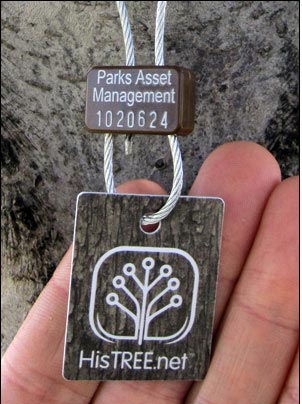In Fort Saskatchewan, RFID Goes Out on a Limb
The Canadian city is using passive EPC tags to track the maintenance of its trees, playground equipment, garbage cans and parks.
Apr. 28, 2011—when workers maintain trees and parks or empty public garbage cans in Fort Saskatchewan, a city of 18,000 residents in Alberta, Canada, they keep record of their daily activities via radio frequency identification. By reading passive ultrahigh-frequency (UHF) EPCGen 2RFID tags attached to the lower limbs of trees, bolted to garbage cans or adhered to swing sets, as well as tags buried in the soil, staff members not only can update city records regarding maintenance status, they can also access details about when an item, such as a tree or a piece of playground equipment, was last serviced, as well as how and by whom.
The city began installing the tags—on hundreds of its trees early this year, and is now also attaching the tags to playground equipment, bolting them to garbage cans and burying then underground at city parks, says Chris Enders, the city’s superintendent of parks and facilities management.
|
According to Enders, the solution began simply as a way to track the city’s thousands of trees, to ensure that they are properly maintained with such services as watering and pruning. When installing new trees in Fort Saskatchewan, developers hire contractors to maintain those trees for the first two years of their lives, before turning their care over to the city, with a guarantee that they were well cared for. Without an RFID system, Enders says, the city can merely conduct visual inspections of those trees during that two-year period, checking whether they are being maintained as expected. With the RFID, however, the city can keep a record of every tree’s maintenance history. After a developer plants trees, a contractor attaches a UHF EPC Gen 2 passive to each tree, by means of a wire cable loop around a lower limb, and then locks it place. The cable passes through a hole, and then a second hole for locking, at which time it is snapped shut and can sustain a 700-pound pull. The tags, manufactured by GAO RFID, consist of an Alien Technology ALN-9629 Square |
RFID inlay encased in a protective plastic shell. Each tag is encoded with a unique ID number. The contractors employ a handheld interrogator to read tags attached to the trees whenever they are serviced (HisTree.net leases Trimble Nomad readers to the contractors for that purpose). When the tag is first input into the system, it is read by the contractor, and data about the tree—such as its age, species and size—is input into the handheld device. The information is then forwarded via a Wi-Fi connection to the back-end server hosted by Histree.net when within range of a Wi-Fi node, or via a GSM cellular connection, explains Art Maat, HisTree.net’s president.
When maintaining a tree—for example, adding water, fertilizer or pruning—a contractor first reads its tag, then inputs data indicating which services were provided. The city can then use a password to log onto Web site and access that information. In that way, if the city notices that a particular tree looks unhealthy, for instance, it can access that tree’s data online and determine how well it is being maintained.
Source : http://www.rfidjournal.com/article/articleview/8397/1/1/







February 6th, 2012 at 3:45 am
hairstyles…
Magnificent goods from you, man. I’ve understand your stuff previous to and you’re just too excellent. I really like what you’ve acquired here, really like what you are saying and the way in which you say it. You make it enjoyable and you still take…